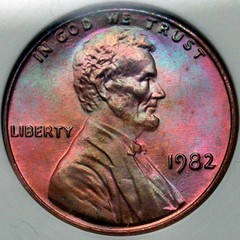 For Lincoln cents, 1982 was a landmark year.
For Lincoln cents, 1982 was a landmark year.
The U.S. Mint made the most significant switch in the composition of circulating coinage since 17 years earlier — when silver was removed from the U.S. dime and quarter and drastically reduced in the half dollar.
In 1982, the value of copper actually began to exceed the face value of the cent.
For well over a century (except for certain, short composition changes as seen with the 1943 steel cents and “shell-case” cents of 1944-1946), the U.S. Mint had been striking cents which using a composition of 95% copper and 5% zinc and tin.
Everything changed with a nearly complete reversal in copper prominence in cents during 1982, when the U.S. Mint started striking cents with a core comprised of 99.2% zinc and .8% copper — along with a thin outer coating of pure copper.
Starting in 1982, copper now comprised just 2.5% of the total metal content in the new Lincoln cents.
The interesting thing about the cents released in 1982 is that not all of them were struck in the now-current predominately zinc composition:
- Billions of 1982 cents were struck from the old copper composition from January through September of that year.
- Zinc cents were first struck late in the year — in October of 1982.
And to top things off… modifications to the die actually led to some 1982 cents bearing so-called “large dates” and others having “small dates.”
Large Date vs. Small Date 1982 Cents
“Large date” 1982 cents can be distinguished from “small date” 1982 cents rather easily — with a good eye and a magnifying glass.
There is a difference in how the numbers appear on a 1982 cent:
- The tops of the numbers all align on a “small date” 1982 penny,
- The large date variety shows the “9” and “8” looking both particularly fuller and also rising a little higher than the “1” and the “2.”
Copper vs. Zinc 1982 Lincoln Memorial Cents
It’s fairly easy to tell the difference between a mainly zinc and mainly copper 1982 cent by weight:
- The copper cent weighs 3.11 grams.
- The zinc cent weighs 2.5 grams.
If you can find a really sensitive gram scale which measures weight to the hundredths, you should have no problem differentiating between zinc and copper 1982 pennies.
If you cannot get access to a coin scale that will read the weights accurately, there is also something called the “drop test.”
I don’t particularly like this method, because dropping coins subjects them to the chance of damage. However, since 1982 cents are worth only face value in circulated grades and they’re worth very slight premiums in average uncirculated grades, I suppose the only thing you lose when dropping 1982 cents is adherence to the old numismatists’ adage “never drop a coin.”
When dropped from the same height and upon the same surface:
- Copper cents create a thud sound when dropped.
- Zinc cents hit the surface with a quieter tone.
7 Varieties of 1982 Lincoln Memorial Cents
All in all, among the different large date and small date changes, as well as the copper and zinc switch-up, there were 7 different regular-issue cents resulting from all the variations:
- 1982 Copper Large Date
- 1982 Copper Small Date
- 1982-D Copper Large Date
- 1982 Zinc Large Date
- 1982 Zinc Small Date
- 1982-D Zinc Large Date
- 1982-D Zinc Small Date
1982 Lincoln Memorial Penny Values
As of today, no extra monetary value is placed on any worn 1982 cents.
The only increase over face value you will find among 1982 cents comes that those that are uncirculated:
- Copper 1982 pennies sell for 30 cents to 50 cents apiece in average-quality uncirculated.
- Zinc 1982 pennies sell for $1 to $3 apiece in typical uncirculated grades, depending on the mint mark and date-size combination.
To Find Out More…
There are many websites where you can go to discover more information about 1982 Lincoln cents. Among the ones I like the best is an article on 1982 Lincoln cents from the Numismatic Guaranty Corporation (NGC) website.
I also like this article that talks about science projects which can be done with Lincoln cents — because it discusses in great detail the copper versus zinc properties, and even a bit about dropping pennies to discern which are copper and which are zinc.




